Preparation and Characterization of Ethylenediamine-Polyurea Microcapsule Epoxy Self-Healing Coating
Abstract
:1. Introduction
2. Materials and Methods
2.1. Materials
2.2. Synthesis of EDA-Polyurea Microcapsules
2.3. Morphology of the Microcapsules
2.4. FTIR Spectroscopy of the Microcapsules
2.5. Thermal Analysis and Core Content of the Microcapsules
2.6. Preparation and Characterization of the Self-Healing Coating
3. Results and Discussion
3.1. Influence of Emulsifier Content on the Microcapsules
3.2. Influence of Rotating Speed on the Microcapsules
3.3. Chemical Structure of the Microcapsules
3.4. Electrochemical Corrosion Resistance of the Self-Healing Coating
4. Conclusions
- The effect of emulsifier content on the morphology distribution of microcapsules showed that the optimal amount of emulsifier SDBS was 15.0 wt%. Meanwhile, in order to obtain well-formed and evenly distributed microcapsules, the rotational speed of the EDA emulsion and prepolymer emulsion should both be set at 2000 rpm.
- The FTIR spectrum indicated that the microcapsules were composed of both EDA (core materials) and Polyurea (shell materials). The mean diameter and core fraction of the final microcapsules were 0.54–0.70 μm and 56.00%, respectively. Moreover, compared with pure core material, the EDA encapsulated by microcapsules had a remarkably improvement in thermal stability, with the initial complete decomposition temperature of 159 °C increasing to the final 302 °C.
- For the accelerated corrosion process, the scratched epoxy coatings coated with 5.0 wt% microcapsules exhibited excellent corrosion resistance, reaching 93.57% of self-healing efficiency after immersion for 366 h in seawater at 25 °C. The self-healing process of cracks was observed by SEM, the cracks in M5 were filled with a huge number of microcapsules, providing a great barrier for the coating, with results that were highly consistent with EIS data, indicating great potential for the use of the obtained microcapsules in self-healing coatings for corrosion resistance.
Author Contributions
Funding
Conflicts of Interest
References
- Behzadnasab, M.; Esfandeh, M.; Mirabedini, S.M.; Zohuriaan-Mehr, M.J.; Farnood, R.R. Preparation and characterization of linseed oil-filled urea–formaldehyde microcapsules and their effect on mechanical properties of an epoxy-based coating. Colloids Surf. A Physicochem. Eng. Asp. 2014, 457, 16–26. [Google Scholar] [CrossRef]
- Koh, E.; Kim, N.-K.; Shin, J.; Kim, Y.-W. Polyurethane microcapsules for self-healing paint coatings. RSC Adv. 2014, 4, 16214–16223. [Google Scholar] [CrossRef]
- Hatami Boura, S.; Peikari, M.; Ashrafi, A.; Samadzadeh, M. Self-healing ability and adhesion strength of capsule embedded coatings—Micro and nano sized capsules containing linseed oil. Prog. Org. Coat. 2012, 75, 292–300. [Google Scholar] [CrossRef]
- Shu, B.; Shaopeng, W.; Lijie, D.; Qing, W.; Quantao, L. Microfluidic Synthesis of Ca-Alginate Microcapsules for Self-Healing of Bituminous Binder. Materials 2018, 11, 630. [Google Scholar] [CrossRef] [PubMed] [Green Version]
- White, S.R.; Sottos, N.R.; Geubelle, P.H.; Moore, J.S.; Kessler, M.R.; Sriram, S.R.; Brown, E.N.; Viswanathan, S. Autonomic healing of polymer composites. Nature 2001, 409, 794–797. [Google Scholar] [CrossRef] [PubMed]
- Homma, D.; Mihashi, H.; Nishiwaki, T. Self-Healing Capability of Fibre Reinforced Cementitious Composites. Materials 2009, 7, 2141–2154. [Google Scholar] [CrossRef] [Green Version]
- Rule, J.D.; Sottos, N.R.; White, S.R. Effect of microcapsule size on the performance of self-healing polymers. Polymer 2007, 48, 3520–3529. [Google Scholar] [CrossRef]
- Vinogradova, O.I.; Lebedeva, O.V.; Kim, B.S. Mechanical Behavior and Characterization of Microcapsules. Annu. Rev. Mater. Res. 2006, 36, 143–178. [Google Scholar] [CrossRef]
- Lee, J.; Zhang, M.; Bhattacharyya, D.; Yuan, Y.C.; Jayaraman, K.; Mai, Y.W. Micromechanical behavior of self-healing epoxy and hardener-loaded microcapsules by nanoindentation. Mater. Lett. 2012, 76, 62–65. [Google Scholar] [CrossRef]
- Hasanzadeh, M.; Shahidi, M.; Kazemipour, M. Application of EIS and EN techniques to investigate the self-healing ability of coatings based on microcapsules filled with linseed oil and CeO2 nanoparticles. Prog. Org. Coat. 2015, 80, 106–119. [Google Scholar] [CrossRef]
- Ding, S.X.; Yan, C.Y.; Min, Z.R.; Ming, Q.Z. Hollow polymeric microcapsules: Preparation, characterization and application in holding boron trifluoride diethyl etherate. Polymer 2009, 50, 560–568. [Google Scholar]
- Lang, S.; Zhou, Q. Synthesis and characterization of poly(urea-formaldehyde) microcapsules containing linseed oil for self-healing coating development. Prog. Org. Coat. 2017, 105, 99–110. [Google Scholar] [CrossRef]
- Es-haghi, H.; Mirabedini, S.M.; Imani, M.; Farnood, R.R. Preparation and characterization of pre-silane modified ethyl cellulose-based microcapsules containing linseed oil. Colloids Surf. A Physicochem. Eng. Asp. 2014, 447, 71–80. [Google Scholar] [CrossRef]
- Selvakumar, N.; Jeyasubramanian, K.; Sharmila, R. Smart coating for corrosion protection by adopting nano particles. Prog. Org. Coat. 2012, 74, 461–469. [Google Scholar] [CrossRef]
- Koh, E.; Lee, S.; Shin, J.; Kim, Y.-W. Renewable Polyurethane Microcapsules with Isosorbide Derivatives for Self-Healing Anticorrosion Coatings. Ind. Eng. Chem. Res. 2013, 52, 15541–15548. [Google Scholar] [CrossRef]
- Biqin, D.; Guohao, F.; Weijian, D.; Yuqing, L.; Jianchao, Z.; Ningxu, H.; Feng, X. Self-healing features in cementitious material with urea–formaldehyde/epoxy microcapsules. Constr. Build. Mater. 2016, 106, 608–617. [Google Scholar]
- Then, S.; Neon, G.S.; Abu Kasim, N.H. Performance of melamine modified urea–formaldehyde microcapsules in a dental host material. J. Appl. Polym. Sci. 2011, 122, 2557–2562. [Google Scholar] [CrossRef] [Green Version]
- Chowdhury, R.A.; Hosur, M.V.; Nuruddin, M.; Tcherbi-Narteh, A.; Kumar, A.; Boddu, V.; Jeelani, S. Self-healing epoxy composites: preparation, characterization and healing performance. J. Mater. Res. Technol. 2015, 4, 33–43. [Google Scholar] [CrossRef] [Green Version]
- Khoee, S.; Kachoei, Z. Design and development of novel reactive amine nanocontainers for a self-healing epoxy adhesive: Self-repairing investigation using the lap shear test. RSC Adv. 2015, 5, 21023–21032. [Google Scholar] [CrossRef]
- Ye, X.J.; Song, Y.X.; Zhu, Y.; Yang, G.C.; Rong, M.Z.; Zhang, M.Q. Self-healing epoxy with ultrafast and heat-resistant healing system processable at elevated temperature. Compos. Sci. Technol. 2014, 104, 40–46. [Google Scholar] [CrossRef]
- Takahashi, T.; Taguchi, Y.; Tanaka, M. Preparation of polyurea microcapsules containing pyrethroid insecticide with hexamethylene diisocyanate isocyanurate. J. Appl. Polym. Sci. 2008, 107, 2000–2006. [Google Scholar] [CrossRef]
- Wang, W.; Xu, L.; Li, X.; Yang, Y.; An, E. Self-healing properties of protective coatings containing isophorone diisocyanate microcapsules on carbon steel surfaces. Corros. Sci. 2014, 80, 528–535. [Google Scholar] [CrossRef]
- Wu, G.; An, J.; Sun, D.; Tang, X.; Xiang, Y.; Yang, J. Robust microcapsules with polyurea/silica hybrid shell for one-part self-healing anticorrosion coatings. J. Mater. Chem. A 2014, 2, 11614–11620. [Google Scholar] [CrossRef]
- Haghayegh, M.; Mirabedini, S.M.; Yeganeh, H. Preparation of microcapsules containing multi-functional reactive isocyanate-terminated-polyurethane-prepolymer as healing agent, part II: Corrosion performance and mechanical properties of a self healing coating. RSC Adv. 2016, 6, 50874–50886. [Google Scholar] [CrossRef]
- Huang, M.; Yang, J. Facile microencapsulation of HDI for self-healing anticorrosion coatings. J. Mater. Chem. 2011, 21, 11123. [Google Scholar] [CrossRef]
- Yu, G.; Zhang, L.; Dong, W.; West, J.L.; Fu, S. Preparation of thermochromic liquid crystal microcapsules for intelligent functional fiber. Mater. Des. 2018, 147, 28–34. [Google Scholar]
- Sun, D.; Lu, T.; Zhu, X.; Li, B.; Tian, Y. Optimization of synthesis technology to improve the design of asphalt self-healing microcapsules. Constr. Build. Mater. 2018, 175, 88–103. [Google Scholar] [CrossRef]
- Lv, L.; Guo, P.; Xing, F.; Han, N. Trigger efficiency enhancement of polymeric microcapsules for self-healing cementitious materials. Constr. Build. Mater. 2020, 235, 117443. [Google Scholar] [CrossRef]
- Attaei, M.; Calado, L.M.; Taryba, M.G.; Morozov, Y.; Shakoor, R.A.; Kahraman, R.; Marques, A.C.; Montemor, M.F. Autonomous self-healing in epoxy coatings provided by high efficiency isophorone diisocyanate (IPDI) microcapsules for protection of carbon steel. Prog. Org. Coat. 2019, 19, 105445. [Google Scholar] [CrossRef]
- Lee, S.-H.; Shin, S.-R.; Lee, D.-S. Self-healing of cross-linked PU via dual-dynamic covalent bonds of a Schiff base from cystine and vanillin. Mater. Des. 2019, 172, 107774. [Google Scholar] [CrossRef]
- Ye, Z.; Zhang, P.; Zhang, J.; Deng, L.; Zhang, J.; Lin, C.; Guo, R.; Dong, A. Novel dual-functional coating with underwater self-healing and anti-protein-fouling properties by combining two kinds of microcapsules and a zwitterionic copolymer. Prog. Org. Coat. 2019, 127, 211–221. [Google Scholar] [CrossRef]
- Navarchian, A.H.; Najafipoor, N.; Ahangaran, F. Surface-modified poly (methyl methacrylate) microcapsules containing linseed oil for application in self-healing epoxy-based coatings. Prog. Org. Coat. 2019, 132, 288–297. [Google Scholar] [CrossRef]
- Zhang, C.; Wang, H.; Zhou, Q. Preparation and characterization of microcapsules based self-healing coatings containing epoxy ester as healing agent. Prog. Org. Coat. 2018, 125, 403–410. [Google Scholar] [CrossRef]
- Li, J.; Feng, Q.; Cui, J.; Yuan, Q.; Qiu, H.; Gao, S.; Yang, J. Self-assembled graphene oxide microcapsules in Pickering emulsions for self-healing waterborne polyurethane coatings. Compos. Sci. Technol. 2017, 151, 282–290. [Google Scholar] [CrossRef]
- Chen, W.; Liu, X.; Lee, D.W. Fabrication and characterization of microcapsules with polyamide–polyurea as hybrid shell. J. Mater. Sci. 2011, 47, 2040–2044. [Google Scholar] [CrossRef]
- Li, Q.; Mishra, A.K.; Kim, N.H.; Kuila, T.; Lau, K.-T.; Lee, J.H. Effects of processing conditions of poly(methylmethacrylate) encapsulated liquid curing agent on the properties of self-healing composites. Compos. Part B Eng. 2013, 49, 6–15. [Google Scholar] [CrossRef]
- Caruso, M.M.; Blaiszik, B.J.; Jin, H.; Schelkopf, S.R.; Stradley, D.S.; Sottos, N.R.; White, S.R.; Moore, J.S. Robust, Double-Walled Microcapsules for Self-Healing Polymeric Materials. ACS Appl. Mater. Interfaces 2010, 2, 1195. [Google Scholar] [CrossRef]
- Shao, Y.; Huang, H.; Zhang, T.; Meng, G.; Wang, F. Corrosion protection of Mg–5Li alloy with epoxy coatings containing polyaniline. Corros. Sci. 2009, 51, 2906–2915. [Google Scholar] [CrossRef]
- Golestani, G.; Shahidi, M.; Ghazanfari, D. Electrochemical evaluation of antibacterial drugs as environment-friendly inhibitors for corrosion of carbon steel in HCl solution. Appl. Surf. Sci. 2014, 308, 347–362. [Google Scholar] [CrossRef]
- Vijayan, P.; Al-Maadeed, M. Self-Repairing Composites for Corrosion Protection: A Review on Recent Strategies and Evaluation Methods. Materials 2019, 12, 2754. [Google Scholar]
- Fu, J.; Chen, T.; Wang, M.; Yang, N.; Li, S.; Wang, Y.; Liu, X. Acid and alkaline dual stimuli-responsive mechanized hollow mesoporous silica nanoparticles as smart nanocontainers for intelligent anticorrosion coatings. ACS Nano 2013, 7, 11397–11408. [Google Scholar] [CrossRef] [PubMed]
- Neema, S.; Selvaraj, M.; Raguraman, J.; Ramu, S. Investigating the self healing process on coated steel by SVET and EIS techniques. J. Appl. Polym. Sci. 2013, 127, 740–747. [Google Scholar] [CrossRef]
- Li, H.; Cui, Y.; Li, Z.; Zhu, Y.; Wang, H. Fabrication of microcapsules containing dual-functional tung oil and properties suitable for self-healing and self-lubricating coatings. Prog. Org. Coat. 2018, 115, 164–171. [Google Scholar] [CrossRef]
- Yang, H.; Mo, Q.; Li, W.; Gu, F. Preparation and Properties of Self-Healing and Self-Lubricating Epoxy Coatings with Polyurethane Microcapsules Containing Bifunctional Linseed Oil. Polymers 2019, 11, 1578. [Google Scholar] [CrossRef] [PubMed] [Green Version]
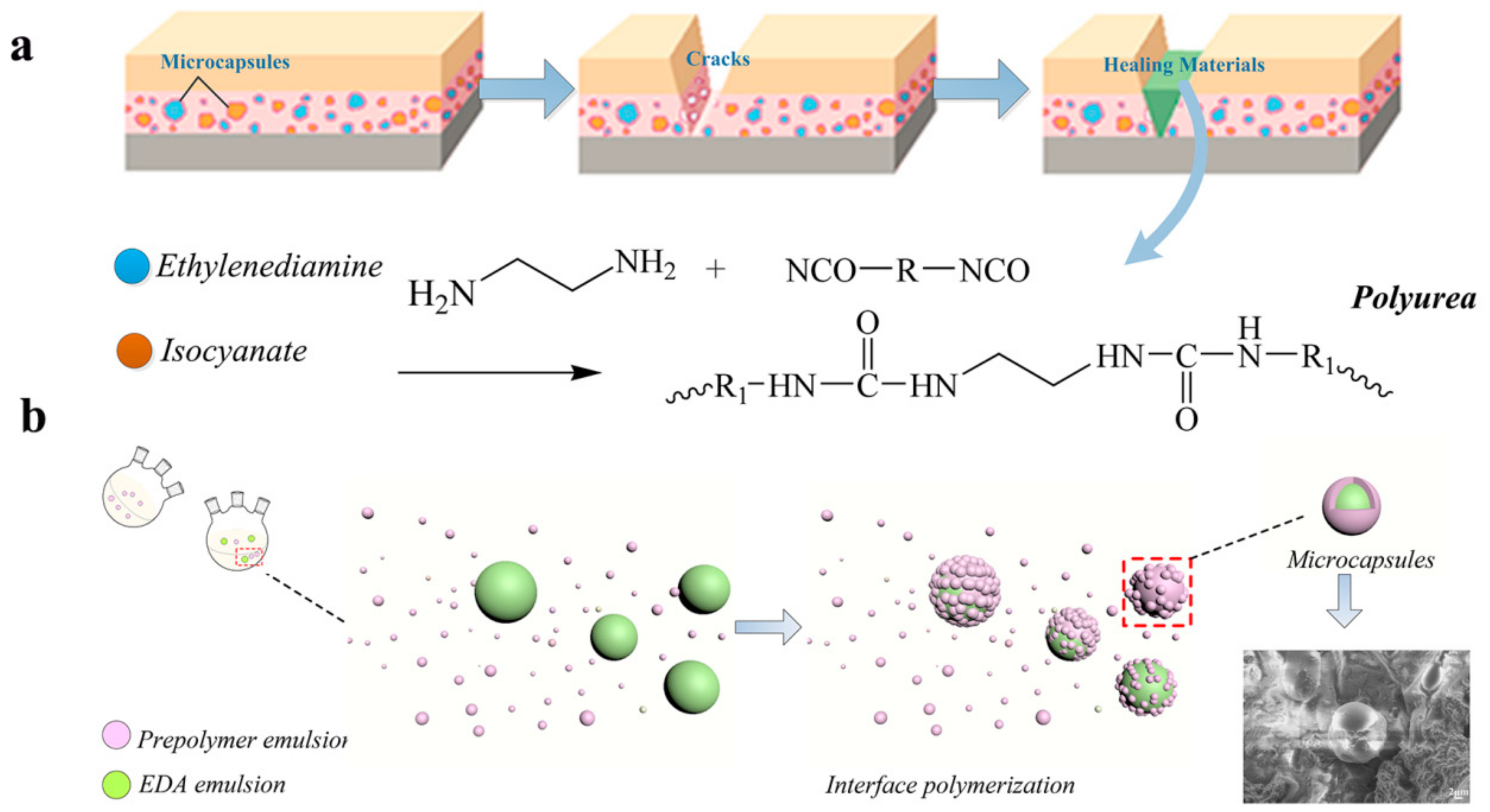
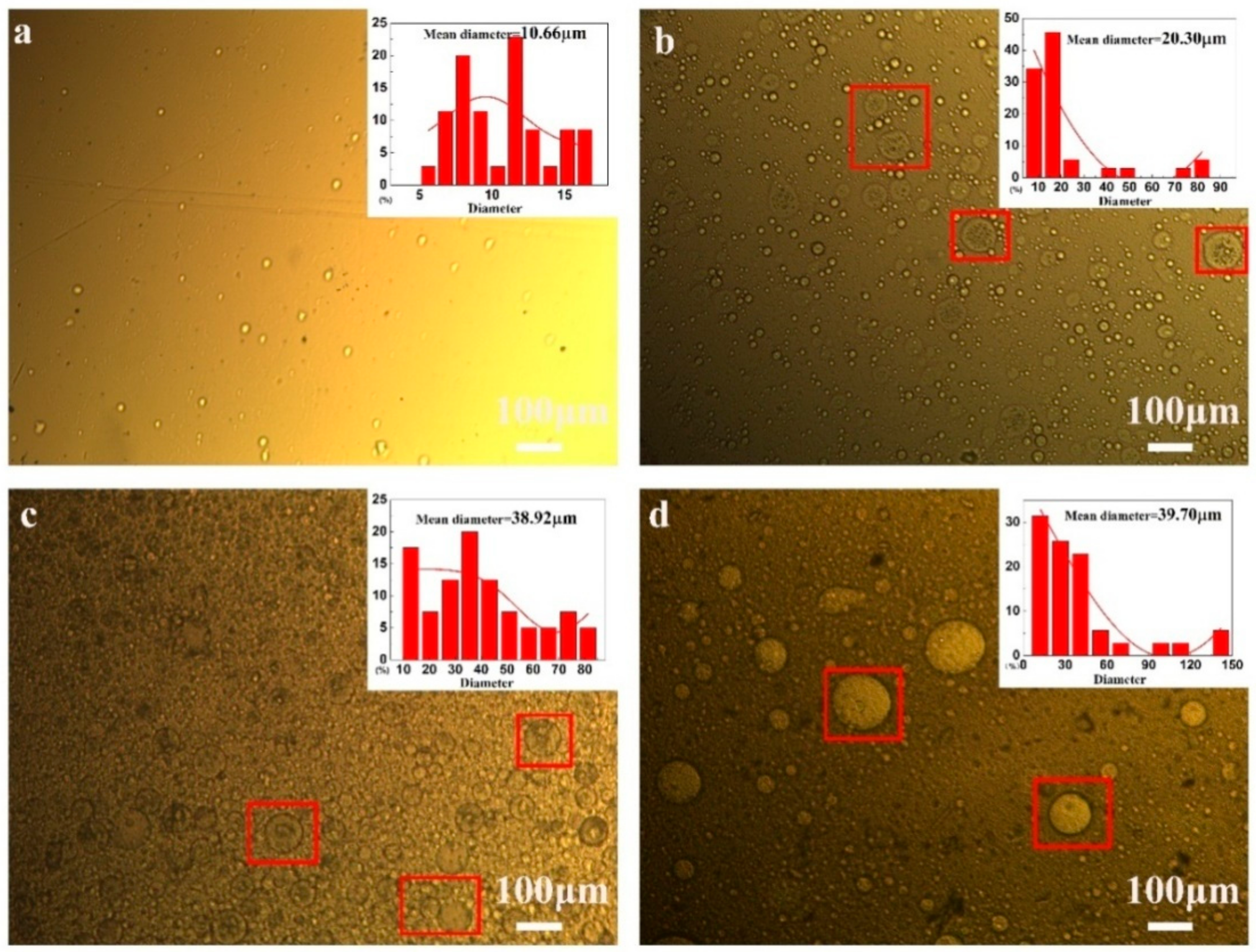
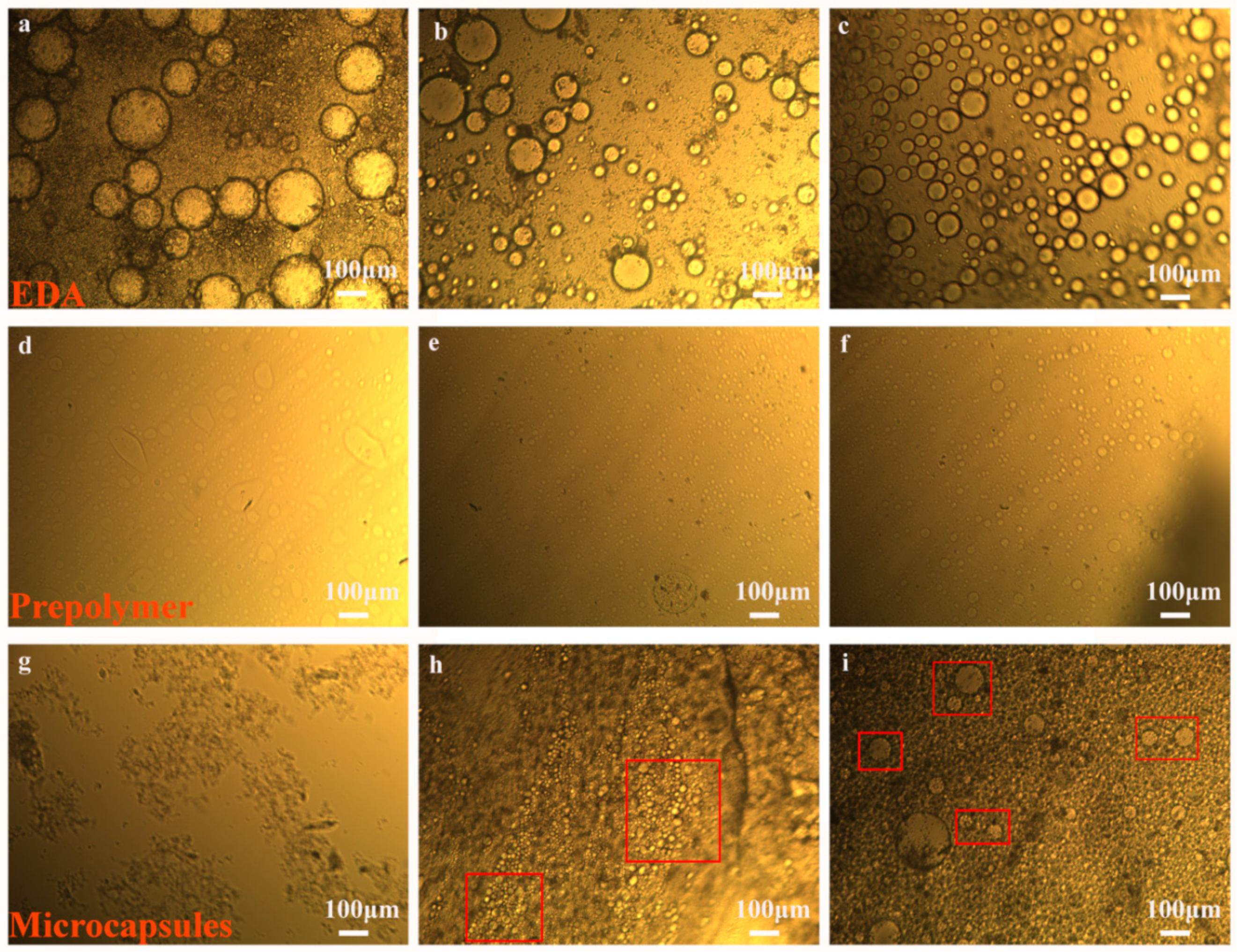
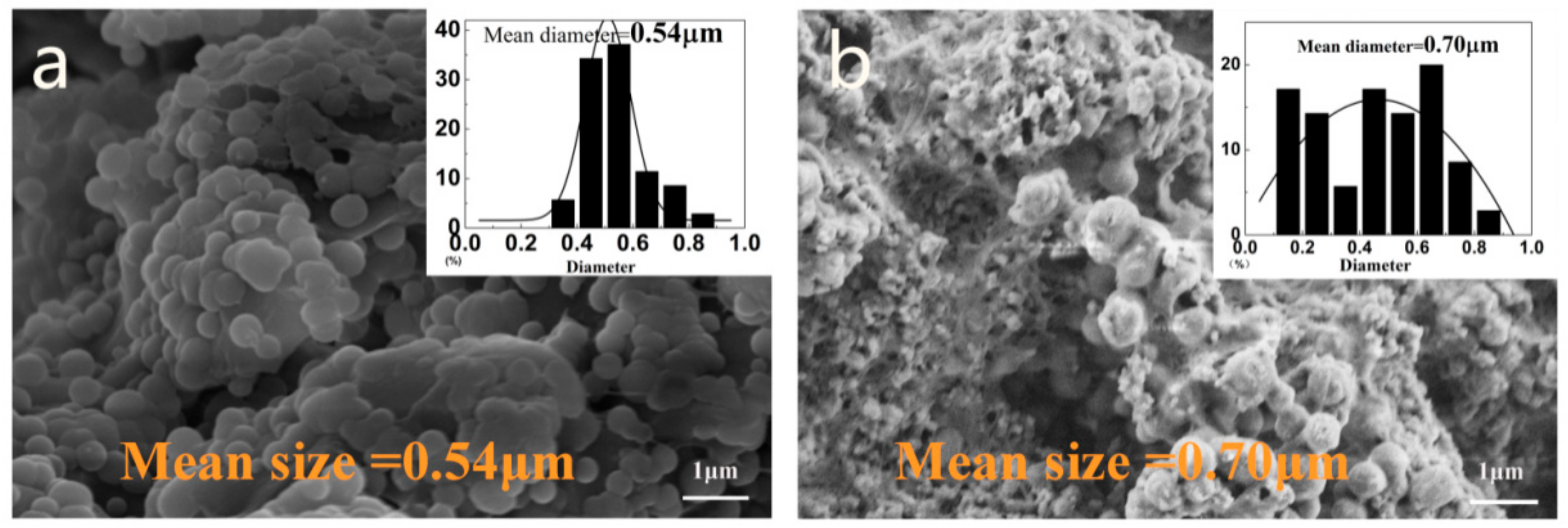


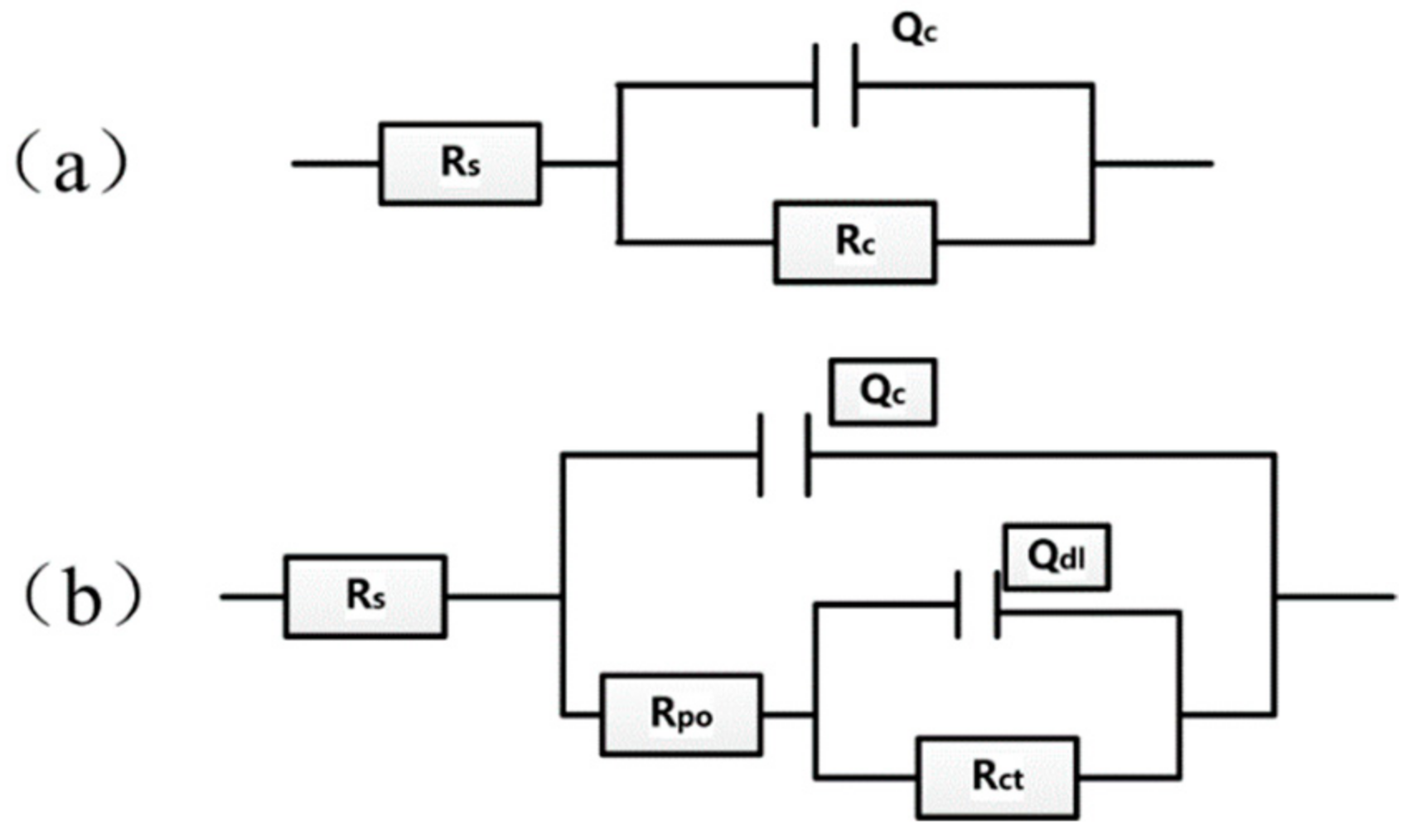

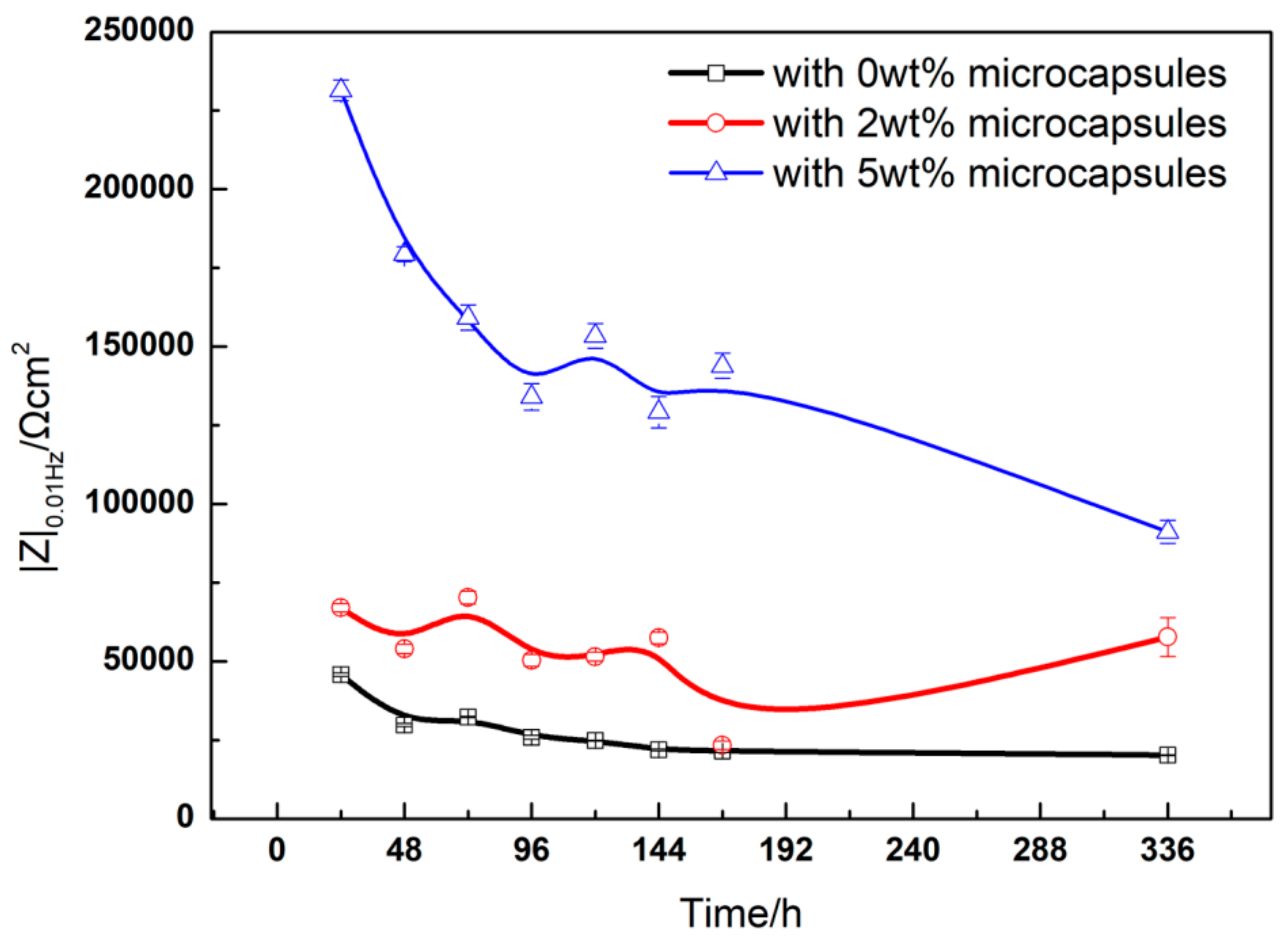
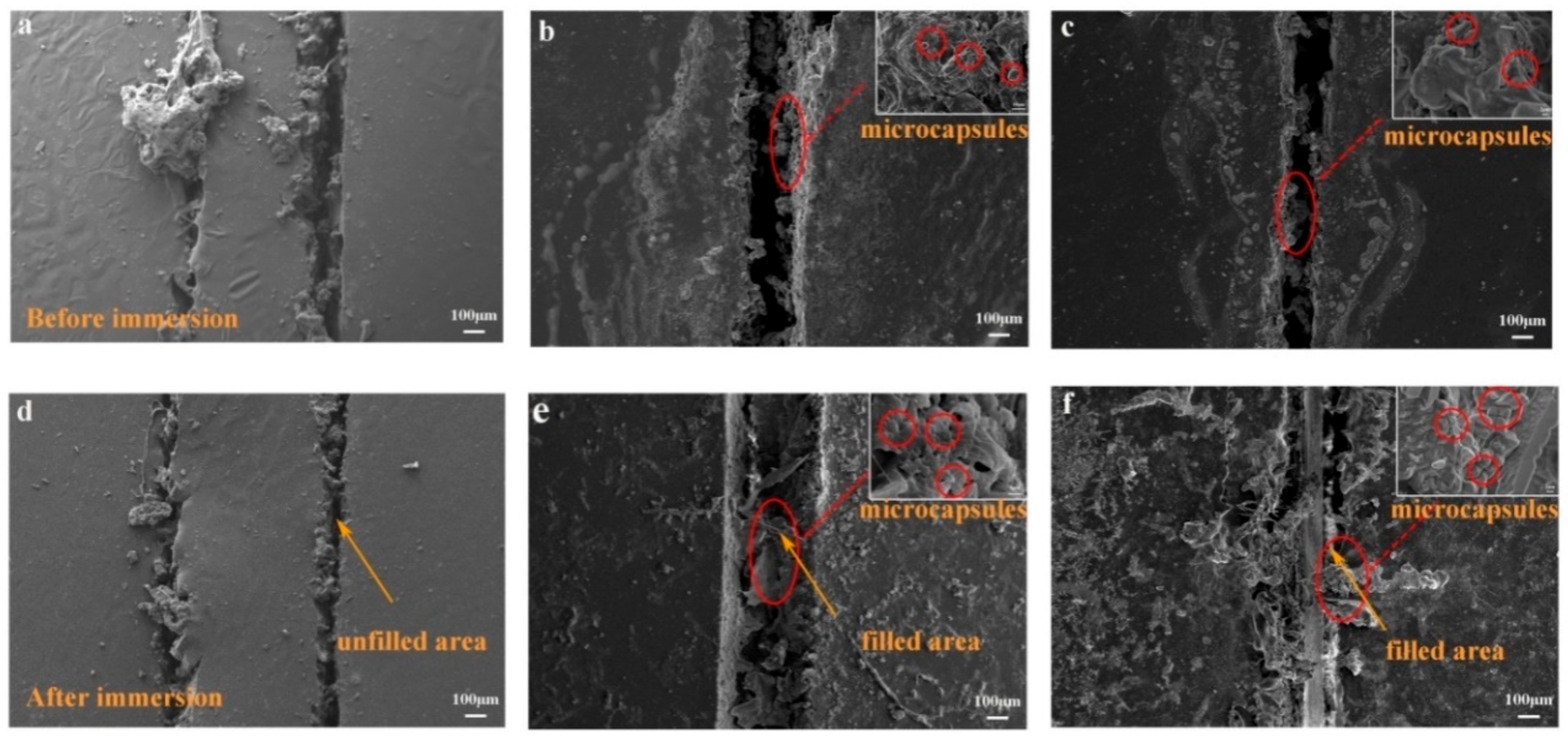
| Time(h) | Content (wt%) | Rs (Ω·cm2) | Qc(F·cm−2) | Rc(Ω·cm2) |
|---|---|---|---|---|
| 24 h | 0.0 | 12.02 | 1.06 × 10−4 | 8.16 × 104 |
| 2.0 | 51.38 | 7.24 × 10−5 | 1.27 × 105 | |
| 5.0 | 51.56 | 4.03 × 10−5 | 1.95 × 106 | |
| 48 h | 0.0 | 11.82 | 1.91 × 10−4 | 6.83 × 104 |
| 2.0 | 49.57 | 1.03 × 10−4 | 1.50 × 105 | |
| 5.0 | 51.15 | 4.75 × 10−5 | 1.19 × 106 | |
| 72 h | 0.0 | 12.27 | 1.63 × 10−4 | 6.71 × 104 |
| 2.0 | 48.83 | 7.83 × 10−5 | 2.13 × 105 | |
| 5.0 | 51.38 | 5.28 × 10−5 | 9.74 × 105 |
| Time (h) | Content (wt%) | Rs (Ω·cm2) | Qc (F·cm−2) | Rpo (Ω·cm2) | Qdl (F·cm−2) | Rct (Ω·cm2) | CRE (%) |
|---|---|---|---|---|---|---|---|
| 96 h | 0.0 | 11.17 | 1.92 × 10−4 | 72.39 | 2.61 × 10−5 | 7.32 × 104 | – |
| 2.0 | 46.31 | 9.52 × 10−5 | 1312 | 1.39 × 10−5 | 1.45 × 105 | 49.52 | |
| 5.0 | 45.05 | 4.25 × 10−5 | 99.71 | 1.65 × 10−5 | 8.04 × 105 | 90.90 | |
| 120 h | 0.0 | 11.35 | 1.97 × 10−4 | 87.62 | 2.34 × 10−5 | 6.49 × 104 | – |
| 2.0 | 45.55 | 9.38 × 10−5 | 1379 | 1.76 × 10−5 | 1.66 × 105 | 60.90 | |
| 5.0 | 46.15 | 4.12 × 10−5 | 127.20 | 9.63 × 10−6 | 1.15 × 106 | 94.36 | |
| 144 h | 0.0 | 10.69 | 2.10 × 10−4 | 68.26 | 3.19 × 10−5 | 5.72 × 104 | – |
| 2.0 | 44.77 | 8.66 × 10−5 | 1478 | 1.46 × 10−5 | 1.91 × 105 | 70.05 | |
| 5.0 | 45.39 | 4.36 × 10−5 | 99.38 | 1.62 × 10−5 | 7.94 × 105 | 92.80 | |
| 168 h | 0.0 | 10.66 | 2.24 × 10−4 | 108.6 | 1.13 × 10−5 | 5.92 × 104 | – |
| 2.0 | 37.35 | 8.09 × 10−5 | 1018.8 | 1.34 × 10−5 | 1.89 × 105 | 68.68 | |
| 5.0 | 46.62 | 4.36 × 10−5 | 118.4 | 1.23 × 10−5 | 9.20 × 105 | 93.57 | |
| 366 h | 0.0 | 10.02 | 1.88 × 10−4 | 35.14 | 4.68 × 10−4 | 4.23 × 104 | – |
| 2.0 | 32.93 | 7.59 × 10−5 | 860.6 | 1.94 × 10−5 | 1.85 × 105 | 77.13 | |
| 5.0 | 41.94 | 5.66 × 10−5 | 166.5 | 6.46 × 10−6 | 3.31 × 105 | 87.22 |
© 2020 by the authors. Licensee MDPI, Basel, Switzerland. This article is an open access article distributed under the terms and conditions of the Creative Commons Attribution (CC BY) license (http://creativecommons.org/licenses/by/4.0/).
Share and Cite
Ma, Y.; Zhang, Y.; Liu, J.; Sun, Y.; Ge, Y.; Yan, X.; Wu, J. Preparation and Characterization of Ethylenediamine-Polyurea Microcapsule Epoxy Self-Healing Coating. Materials 2020, 13, 326. https://doi.org/10.3390/ma13020326
Ma Y, Zhang Y, Liu J, Sun Y, Ge Y, Yan X, Wu J. Preparation and Characterization of Ethylenediamine-Polyurea Microcapsule Epoxy Self-Healing Coating. Materials. 2020; 13(2):326. https://doi.org/10.3390/ma13020326
Chicago/Turabian StyleMa, Yanxuan, Yingrui Zhang, Jiatong Liu, Yi Sun, Yajie Ge, Xiaoning Yan, and Jian Wu. 2020. "Preparation and Characterization of Ethylenediamine-Polyurea Microcapsule Epoxy Self-Healing Coating" Materials 13, no. 2: 326. https://doi.org/10.3390/ma13020326
APA StyleMa, Y., Zhang, Y., Liu, J., Sun, Y., Ge, Y., Yan, X., & Wu, J. (2020). Preparation and Characterization of Ethylenediamine-Polyurea Microcapsule Epoxy Self-Healing Coating. Materials, 13(2), 326. https://doi.org/10.3390/ma13020326





